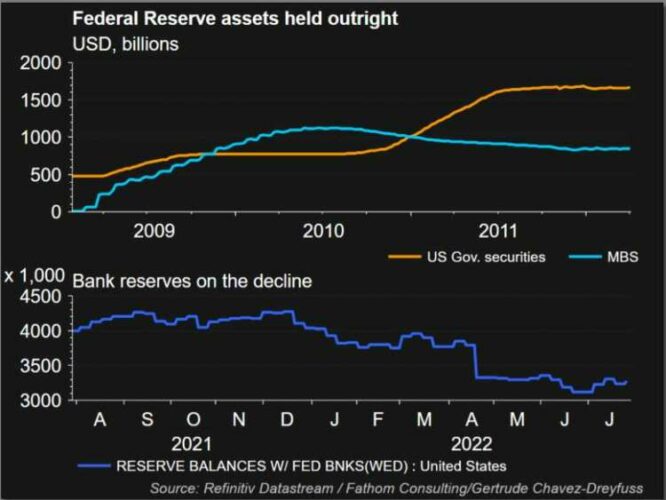By Gertrude Chavez-Dreyfuss
NEW YORK (Reuters) – The trillions of dollars in overnight cash tucked away daily at the Federal Reserve could turn into a major headache for banks that could squeeze their balance sheets and impair their ability to lend.
The Fed’s reverse repurchase facility (RRP) has attracted a wide array of market participants, helping mop up excess liquidity in the financial system. Led by money market funds, volume at the reverse repo window has topped $2 trillion for 39 straight days.
The Fed is paying a record reverse repo rate of 2.3% following its 75-basis-point interest rate hike last week. Barclays expects daily reverse repo levels to hit between $2.8 trillion and $3.0 trillion by the end of the year.
Investors are effectively taking deposits away from banks and putting them into government money market funds, which invest mainly in Treasuries and repos. These money funds, in turn, funnel the cash to the Fed’s overnight window.
Repo allocations from government money market funds have increased to nearly 40% of their assets currently, from around 30% at the start of the year, Barclays said.
The Fed will shrink its balance sheet by $95 billion per month from September, accelerating “quantitative tightening,” which started in June. The concern is that the outflow of deposits from banks into money market funds could reduce bank reserves at a rapid pace that could hinder lending activities to financial markets and the broader economy.
GRAPHIC: Fed Balance Sheet and Bank Reserves (https://fingfx.thomsonreuters.com/gfx/mkt/byprjwzxbpe/Fed%20balance%20and%20bank%20reserves.PNG)

The decline in bank reserves could also lead to a spike in the repo and effective fed funds rate similar to what happened in September 2019 when bank reserves dwindled due to heavy withdrawals for tax payments and settlement of Treasury purchases at auctions. That forced the Fed to provide additional reserves to the banking system.
“The drift of reserves into money market funds and away from banks constitute movement of money away from financial markets,” said Matt Smith, investment director at asset manager Ruffer in London, which has $31 billion in assets under management.
For now, bank reserves are still considered abundant at $3.3 trillion, but the decline has been rapid, some market participants said. From a peak of nearly $4.3 trillion in December last year, bank reserves have declined about 23%. In the Fed’s previous quantitative tightening (QT), $1.3 trillion in liquidity was withdrawn in five years.
To be sure, there are other factors that have contributed to the decline in bank reserves, such as asset re-allocations and loan demand, analysts said.
MONEY MARKET FUND ASSETS
Government money market fund assets have been fairly steady as of July 27, at $4.025 trillion, up about 0.1% from a week earlier, data from the Investment Company Institute showed. The shift of deposits to money funds has been a slow process.
“The Fed’s QT will shrink its balance sheet quickly. But bank reserves are set to fall much faster as cash shifts out of bank deposits to government-only money funds. We expect money funds to put this cash in the RRP,” wrote Joseph Abate, managing director at Barclays, in a research note.
Expectations that the U.S. Treasury will increase bill issuance for fiscal year 2023, which starts in October, could help ease the surfeit of inflows into the reverse repo window, analysts said.
Abate estimated that bank reserves will fall to $2.3 trillion this year, perilously near what he termed banks’ “minimally ample level” of $2 trillion, as the exit of deposits starts to weigh on their balance sheets.
Yet for many big banks, those deposits are unwanted anyway.
As the Fed’s balance sheet increased with quantitative easing during the pandemic, so did bank reserves deposited at the central bank. Once reserves reached a level at which banks were not willing to absorb the regulatory costs on their balance sheets, they started turning deposits away.
The Fed in April 2020 temporarily excluded Treasuries and central bank deposits from the supplementary leverage ratio (SLR), a capital adequacy measure, as an excess of bank deposits and Treasury bonds raised bank capital requirements on what are viewed as safe assets.
But the Fed let that SLR exclusion expire and big banks had to resume holding an extra layer of loss-absorbing capital against Treasuries and central bank deposits.
“Banks are still not keen to increase deposits due to regulatory costs in the absence of SLR relief and want to free up their balance sheet,” said Imran Siddiqui, portfolio manager at Mosaic Capital. “In a subtle way, they are sending a message to the Fed to provide some form of permanent SLR relief.”
Should the Fed tweak the SLR and give banks breathing room on regulatory costs, that should push these financial institutions to accept more deposits and help stabilize reserves. The Fed earlier this year said it would review this leverage ratio, but has yet to publish a proposal.
(Reporting by Gertrude Chavez-Dreyfuss; Editing by Alden Bentley and Leslie Adler)


